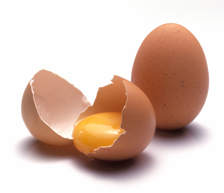Australian egg consumption on the rise

Australians have increased their egg consumption with gusto, eating seven percent more eggs in the past year, according to statistics released by the Australian Egg Corporation Ltd.
The Australian egg industry has responded by producing a total of 392 million dozen eggs during 2011 or 12.9 million eggs each day. This represents an increase of 10% on 2010 levels and up by 22% on the 5-year average or an increase of 51% since 2000.
AECL Managing Director, James Kellaway said that in the past year, each Australian ate on average a whopping 213 eggs, up from the 198 eggs consumed in 2010.
“These statistics prove that the humble egg has become a central part of the diet of Australians – be it breakfast, lunch or dinner, eggs are a versatile, nutritious and very affordable food that Australians are eating… with great gusto!” Kellaway said.
Egg retail sales
In terms of retail sales, a total of 128.4 million dozen (worth $523.5 million) were sold, which is up by 5% on the volumes sold in 2010 and up by 19% on the 5-year average with long term annual growth also averaging 5% each year. This compares to population growth in Australia that averages 1.5% each year.
“We believe the increased consumption is due to a growing awareness of new science that proves that eggs do not increase cholesterol as previously thought and that people can safely eat six eggs a week (according to the Heart Foundation). Not only that, new science shows that egg consumption can help people with diabetes and assist reduce obesity in the community,” Kellaway said.
On a segment basis, cage egg retail sales totaled 71 million dozen, down by 1% on 2010 levels but up by 2% on the 5-year average. Free range retail egg sales reached 43 million, up by a massive 24% on 2010 levels and up by 64% on the 5-year average. Barn-laid retail egg sales fell to total 11 million dozen, down by 3%, but increased by 64% on the 5-year average.
Free range eggs
“The increase in free range retail sales was driven, in part, by the lowest free range retail prices since 2006. In terms of market shares in 2011, cage eggs owned 55% of the retail market with free range eggs representing 34%. Barn-laid eggs remained subdued at 9% of the retail market with organic and other specialty eggs representing 2% of the market,” he said.
“While Australians have increased their egg consumption in the past two years, Mexicans and Japanese eat considerably more eggs than us. According to the International Egg Commission, Mexicans ate a whopping 365 eggs while Japanese people ate 324 eggs in the past year,” he said.
Source: Australian Egg Corporation Ltd













